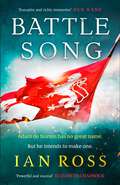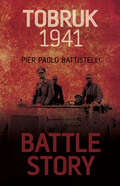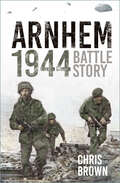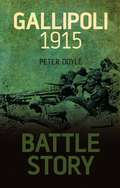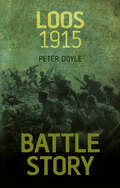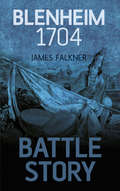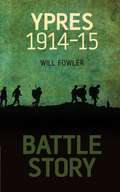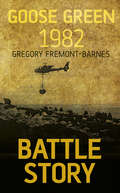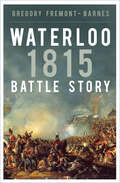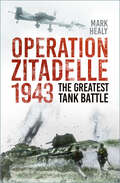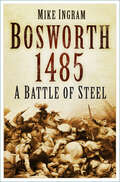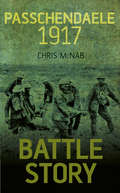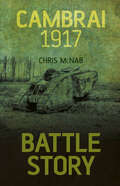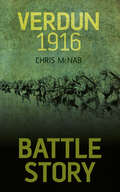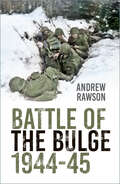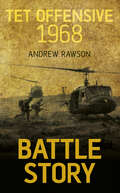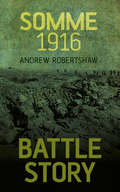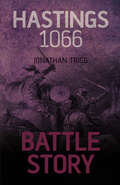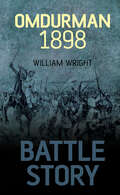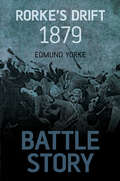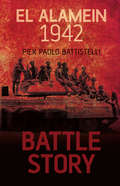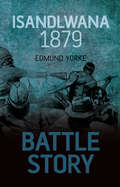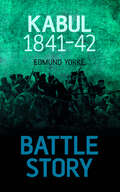- Table View
- List View
Battle Song: The 13th century historical adventure for fans of Bernard Cornwell and Ben Kane (de Norton trilogy)
by Ian Ross'There is a fury in England that none shall suppress - and when it breaks forth it will shake the throne'1264 Storm clouds are gathering as Simon de Montfort and the barons of the realm challenge the power of Henry III. The barons demand reform; the crown demands obedience. England is on the brink of civil war. Adam de Norton, a young squire devoted to the virtues of chivalry, longs only to be knighted, and to win back his father's lands. Then a bloody hunting accident leaves him with a new master: the devilish Sir Robert de Dunstanville, who does not hesitate to use the blackest stratagems in pursuit of victory. Following Robert overseas, Adam is introduced to the ruthless world of the tournament, where knights compete for glory and riches, and his new master's methods prove brutally effective. But as England plunges into violence, Robert and Adam must choose a side in a battle that will decide the fate of the kingdom. Will they fight for the king, for de Montfort - or for themselves? Searingly vivid and richly evocative, Battle Song is tale of friendship and chivalry, rivalry and rebellion, and the medieval world in all its colour and darkness.
Battle Story: Tobruk 1941 (Battle Story Ser.)
by Pier Paolo BattistelliThe siege of Tobruk lasted 240 days during which the ‘gallant garrison’ of Allied soldiers, including the famous ‘Desert Rats’ held out against constant attacks from Rommel’s Afrika Korps. The battle became one of the longest sieges in British military history and a potent symbol of British resistance. To understand what happened and why – read Battle Story. Diary extracts and quotes offer a real insight into what it was like for the Allied soldiers to live under siege. Maps highlight the adversities of the terrain and the strategic importance of the Tobruk fortress. Rare photographs place you on the frontline of the unfolding action. Orders of battle reveal the composition of the opposing forces’ armies. Packed with fact boxes, this short introduction is the perfect way to explore this important battle.
Battle Story: El Alamein 1942 / Arnhem 1944 / Iwo Jima 1945 (Battle Story Ser. #7)
by Chris BrownWhen we think of Arnhem we think of A Bridge Too Far and a sky full of parachutes dropping the Allies into the Netherlands. Beyond these images, this was one fo the most complex and strategically important operations of the war. Operation Market Garden was devised to give the Allies the opportunity to bypass the German Siegfried Line and attack the Ruhr. Paratroopers were dropped into the Netherlands to secure all the bridgeheads and major routes along the proposed Allied axis advance. Simultaneously the 1st Airborne Division, supported by the Glider Pilot Regiment and Polish 1st Independent Parachute Brigade, landed at Arnhem. The British expected to sweep through and connect with the Arnhem force within a matter of days. However, things on the ground proved very different. The troops met resistance from pockets of SS soliders and soon were overwhelmed. The Arnhem contingent was cut-off from reinforcement and eventually forced to withdraw. The 1st Airborne Division lost three-quarters of its strength in the operation and did not see battle again. Through quotes and maps the text explores the unfolding action of the battle and puts the reader on the frontline. if you truly want to understand what happened and why - read Battle Story.
Battle Story: A New History (Battle Story Ser.)
by Dr Chris BrownBannockburn 1314 is the most celebrated battle between Scotland and England, in which a mere 7,000 followers of Robert the Bruce defeated more than 15,000 of Edward II’s troops. The Battle of Bannockburn, fought over two days on 23 and 24 June 1314 by a small river crossing just south of Stirling, was a decisive victory for Robert, and secured for Scotland de facto independence from England. It was the greatest defeat the English would suffer throughout the Middle Ages, and a huge personal humiliation for Edward. Chris Brown’s account recreates the campaign from the perspectives of both the Scots and English. If you want to know what happened and why read – Battle Story.
Battle Story: Gallipoli 1915 (History Press Ser.)
by Peter DoyleThe Gallipoli campaign was in some ways the brainchild of First Lord of the Admiralty, Winston Churchill, who saw an attack on the Dardanelles as a way to break through the stalemate in supplying the Eastern Front. The preceding naval campaign led many to believe that victory was inevitable. However, increased losses at sea prompted the Allies to send ground troops to invade and eliminate the Ottoman artillery. These ground forces comprised a large ANZAC (Australian and New Zealand) contingent and Gallipoli would be their first major campaign in the war. They invaded on 25 April 1915, landing on 5 stretches of beach in open boats. The casualties from the first landing were horrific, of the first 200 men out of the boats, only 21 reached inland, the rest were mown down by the Ottoman machine-guns. Throughout the campaign losses were severe, with both sides suffering casualties in excess of 200,000 troops. Eventually the Allies were forced to evacuate. The fall out from this disaster was felt in both military and political circles. Battle Story Gallipoli takes you to the frontline and beyond, ensuring that you will appreciate the ultimate sacrifice made by these WWI soldiers.
Battle Story: Loos 1915 (Battle Story Ser.)
by Peter DoyleThe Battle of Loos saw a change in Allied strategy, which up until then had been a series of small-scale assaults that achieved little or no ground gained. Loos was to be different, Kitchener’s Army was deployed in strength for the first time and an ambitious plan aimed to take ground over a 20-mile front. As the fog of war descended the first day’s gains were lost over subsequent days’ fighting and in the end the ‘Big Push’ saw little achieved with Allied losses of about 50,000 men. Through quotes and maps the text explores the unfolding action of the battle and puts the reader on the frontline. If you truly want to understand what happened and why – read Battle Story.
Battle Story: Marlborough's Greatest Victory (Battle Story Ser.)
by James FalknerBlenheim has gone down in history as one of the turning points of the War of the Spanish Succession – and some would say in the history of conflict in Europe. The overwhelming Allied victory ensured the safety of Vienna from the Franco-Bavarian army, thus preventing the collapse of the Grand Alliance. Bavaria was knocked out of the war, and Louis's hopes for a quick victory came to an end. France suffered over 30,000 casualties including the commander-in-chief, Marshal Tallard, who was taken captive to England. Before the 1704 campaign ended, the Allies had taken towns on the Moselle in preparation for the following year's campaign into France itself. It was a brilliant victory for Marlborough, which involved a lightning march of over 250 miles and superb deception – even of his own Dutch allies! Blenheim must be one of the most well known battles – because of Blenheim Palace – but few know why.
Battle Story: Ypres 1914-15 (Battle Story Ser.)
by William E FowlerYpres was a medieval town known for its textiles; however, it became infamous during the Great War with trench warfare, poison gas and many thousands of casualties. As the German Army advanced through Belgium, it failed to take the Ypres Salient. On 13 October 1914, German troops entered Ypres. On looting the city, the Germans retreated as the British Expeditionary Force advanced. On 22 November 1914, the Germans commenced a huge artillery barrage killing many civilians. In 1917, the Third Battle of Ypres commenced making it an exceptionally dangerous place to live. In 1918, a German major offensive was launched, but the British held firm. Ypres was finally safe in late September 1918 when German troops withdrew from the Salient. Today the battlefields of Ypres contain the resting place of thousands of German and British soldiers. This book explores the first and second battles of Ypres through narrative, eye-witness accounts and images.
Battle Story: Goose Green 1982 (Battle Story Ser. #4)
by Gregory Fremont-BarnesThe Battle of Goose Green was the first and longest land conflict of the Falklands War, which was fought between British and Argentine forces in 1982. The British forces, attacking over featureless, wind-swept and boggy ground, were heavily outnumbered and lacked fire support, but brilliantly defeated the Argentine garrison in a fourteen-hour struggle. If you want to understand what happened and why – read Battle Story. Detailed profiles examine the personalities of the British and Argentine commanders, including that of Victoria Cross winner Lt Col ‘H’ Jones. First-hand accounts offer an insight into this remarkable fourteen-hour struggle against the odds. Detailed maps explore the area of Darwin Hill and Goose Green, and the advance of the British forces. Photographs place you at the centre of this pivotal battle. Orders of battle show the composition of the opposing forces’ armies. Packed with fact boxes, this short introduction is the perfect way to explore this crucial battle.
Battle Story: The British Army's Day Of Destiny (Battle Story Ser. #3)
by Gregory Fremont-BarnesThe Battle of Waterloo is one of the most important moments in military history. As the might of the French Empire under the leadership of the Emperor Napoleon faced the Coalition army under Duke of Wellington and Gerhard von Blucher for one last time. The battle saw the culmination of a long campaign to destroy Napoleon's forces and halt the growth of the French Empire. Both sides fought bitterly and Wellington later remarked that 'it was the nearest-run thing you ever saw in your life'. Both armies lost over 20,000 men on the battlefield that day, but it was the coalition that emerged victorious in the end. Wellington's army counter-attacked and threw the French troops into disarray as they fled from the field. The coalition forces entered France and restored Louis XVIII to the throne and Napoleon was exiled to the island of Saint Helena, where he later died. Waterloo was a resounding victory for the British Army and changed the course of European history. This Battle Story tells you everything you need to know about his critical battle.
Battle Story: The Greatest Tank Battle In History (Armour In Theatre Ser. #No. 16)
by Mark HealyIn July 1943, Hitler launched Operation Zitadelle, the last German offensive on the Eastern Front. It was an attempt to shorten the German lines by eliminating the Kursk salient – created after their defeat at Stalingrad – and was designed to result in the encirclement of the Red Army. In reality the German tanks came up against impenetrable Russian defences: minefields, artillery and anti-tank emplacements, spread through lines 250km deep and manned by Russian troops whose actions often verged on the suicidal. The greatest tank battle in history, Kursk assured the Nazis’ defeat and was ‘the swan song of the German tank arm’. Involving over 9000 tanks, 5000 aircraft, 35,000 guns and mortars and 2,700,000 troops (of whom 230,000 became casualties), the Battle of Kursk was a conflict whose scale and barbarity eclipsed all other clashes in Europe. This book gives a clear, concise account of those dramatic days in 1943, supported by a timeline of events and orders of battle, and illustrated with over fifty photographs.
Battle Story: Bosworth 1485 (Battle Story Ser. #6)
by Mike IngramBosworth Field saw the two great dynasties of the day clash on the battlefield: the reigning House of York, led by Richard III, against the rising House of Tudor, led Henry Tudor, soon to become Henry VII. On 22 August 1485 this penultimate battle in the Wars of the Roses was fought with the might of the Lancastrian army ranged against the Yorkists. This book describes how these two great armies came to meet on the battlefield and how the tactics employed by the Yorkists eventually led to their defeat and the death of King Richard III. Through quotes and maps the text explores the unfolding action of the battle and puts the reader on the frontline. If you truly want to understand what happened and why – read Battle Story.
Battle Story: The Third Battle Of Ypres In Photographs (Battle Story Ser. #9)
by Chris McNabPasschendaele 1917 is the story of one of the most pitiless and iconic battles of the First World War, known today as Third Ypres. Fought over three tortuous months in 1917, the fighting raged through some of the worst physical conditions of the entire war, across battlefields collapsing into endless mud and blood. Eventually, more than 500,000 casualties bought front-line changes measured only in hundreds of yards. If you truly want to understand what happened and why – read Battle Story.
Battle Story: Cambrai 1917 (History Press Ser.)
by Chris McNabThe Battle of Cambrai has become synonymous with one of the Allies’ first large-scale use of tanks on the Western Front. Cambrai certainly saw over 450 Mark IV tanks lumber across No Man’s Land and penetrate the Hindenburg Line. For the Germans on the other side of these defences the sheer scale of these ‘iron monsters’ was terrifying, however they quickly rallied and the battle was about much more than the tanks deployed. Chris McNab explores how new techniques of sound-ranging and artillery strategy played a greater part on the battlefield than the tanks which have dominated the history of the battle. At dawn on 20 November 1917 over 1,000 guns fired on German positions and 400 tanks and thousands of men stepped out into the barren land between the trenches. At first, it seemed that success was inevitable, with over 5 miles of ground gained – a significant amount for such an operation, however on the first day of battle 180 tanks were out of action and the attack began to flounder. After days of attack and counterattack, both sides had gained ground, but no definitive success and with over 70,000 casualties. Yet, Cambrai was an important training ground for both sides, proving the effectiveness of new tactics that would lead to greater victories later in the war.
Battle Story: Verdun 1916 (Battle Story Ser.)
by Chris McNabThe Battle of Verdun was one of the bloodiest engagements of the First World War, resulting in 698,000 deaths, 70,000 for each of the 10 months of battle. The French Army in the area were decimated and it is often most tragically remembered as the battle in which the French were ‘bled white’. A potent symbol of French resistance, the fortress town of Verdun was one that the French Army was loath to relinquish easily. It was partly for this reason that the German commander chose to launch a major offensive here, where he could dent French national pride and military morale. His attack commenced on 21 February, using shock troops and flamethrowers to clear the French trenches. Starting with the capture of Fort Douamont, by June 1916 the Germans were pressing on the city itself, exhausting their reserves. The French continued to fight valiantly, despite heavy losses and eventually rolled back German forces from the city. In the end it was a battle that saw much loss of life for little gain on either side.
Battle Story: Iwo Jima 1945 (Battle Story Ser. #1)
by Andrew RawsonOperation Detachment, the US invasion of Iwo Jima on 19 February 1945, was the first campaign on Japanese soil and resulted in some of the fiercest fighting in the Pacific. If you truly want to understand what happened and why – read Battle Story. Detailed profiles explore the leaders, tactics and equipment of the US and Japanese armies. Nine specially commissioned maps track the progress of the battle and the shifting frontlines. Rare photographs place you in the centre of the unfolding action. Diary extracts and quotes give you a soldier’s eye-view of the battle. Orders of Battle reveal the composition of the opposing forces’ armies. Packed with fact boxes, this short introduction is the perfect way to explore this important battle.
Battle Story: The Battle Of The Bulge 1944-45 (Battle Story Ser.)
by Andrew RawsonIn December 1944 the German military made their final attempt to end the Second World War by throwing in all their reserves in a desperate attempt to shatter the Allied lines. After breaking through the American-held sector in the Ardennes, two Panzer armies headed for the bridges over the River Meuse. However, a combination of poor planning, bad weather, tortuous terrain and above all, the determined defence of key towns and villages, such as Bastogne and St Vith, delayed the advance. The Allies were able to hold the northern and southern shoulders of the attack, hemming the Germans in. The Bulge had been created, and as the fortunes of battle were reversed, the Allies struck back. This book gives a clear, concise account of those dramatic days at the end of 1944, supported by a timeline of events and orders of battle. Over fifty photographs illustrate the events during this momentous campaign.
Battle Story: Tet Offensive 1968 (Battle Story Ser.)
by Andrew RawsonBy the end of January 1968 the American people thought their armed forces were winning in South Vietnam after three years of escalating confl ict. Then the North Vietnamese Army and Viet Cong struck back, hitting military and political targets across the country. While the NVA and Viet Cong suffered a military defeat, they dealt a huge blow to US support for the war. If you want to understand what happened and why - read Battle Story. Detailed profiles examine the background of the opposing commanders, as well as the contrasting tactics and equipment of their fighting forces. Contemporary accounts reveal the true story of this pivotal battle and its consequences for the Vietnam War. Specially commissioned maps analyse the key developments during the battle. Excellent photographs place the reader at the centre of the fighting. Orders of battle show the composition of the opposing forces’ armies.
Battle Story: Tragedy And Triumph (Battle Story Ser. #10)
by Andrew RobertshawThe Battle of the Somme raged from 1 July to 18 November 1916 and was one of the bloodiest fought in military history. It has come to signify for many the waste and bloodshed of the First World War as hundreds of thousands of men on all sides lost their lives fighting over small gains in land. Yet, this battle was also to mark a turning point in the war and to witness new methods of warfare, such as all-arms integrated attacks, with infantry units and the new Tank Corps fighting alongside each other. In this Battle Story, Andrew Robertshaw seeks to lift the battle out of its controversy and explain what really happened and why. Complete with detailed maps and photographs, as well as fascinating facts and profiles of the leaders, this is the best introduction to this legendary battle.
Battle Story: Hastings 1066 (Battle Story Ser. #8)
by Jonathan TriggIn 1066 the most significant battle on English soil – and arguably the most important in British history – took place some six miles northwest of Hastings. A king would die on the battlefield and a new dynasty would be established. The fighting exemplified the superiority of an all-arms combined attack employing foot soldiers, cavalry and archers against massed infantry. To understand what happened and why – read Battle Story. Photographs of the battlefield today, artist’s interpretations and of course reproductions from the Bayeux tapestry place you in the centre of the action. Easy-to-read maps plot each development in the struggle. Descriptions of the weaponry, armour and tactics of the combatants help explain why the famous housecarls of England were obliterated for all time. Packed with fact boxes, this short introduction is the perfect way to explore a turning point in British and European history.
Battle Story: Omdurman 1898 (Battle Story Ser.)
by William WrightThe battle took place at Kerreri, 11km north of Omdurman in the Sudan. Kitchener commanded a force of 8,000 British regulars and a mixed force of 17,000 Sudanese and Egyptian soldiers. He arrayed his force in an arc around the village of Egeiga close to the bank of the Nile, where a gunboat flotilla waited in support, facing a wide, flat plain with hills rising to the left and right. The British and Egyptian cavalry were placed on either flank. Al-Taashi's followers, known as Ansar and sometimes referred to as Dervishes, numbered around 50,000, including some 3,000 cavalry. In a few hours and at a loss of less than 400 officers and men killed and wounded, the Anglo-Egyptian army defeated the 50,000 brave tribesmen who charged their enemy, regardless of the hail of Maxim bullets, many of them armed only with spears, swords and ancient chainmail armour.In concise detail, with orders of battle, maps and over fifty images, the author shows how Omdurman was a superb example of tactics in warfare. First-hand accounts from both sides help the reader to understand all the horrors and glory of that day including the famous charge of the 21st Lancers, often called the last great cavalry charge of the British Army. This was arguably the height of British Empire military dominance.
Battle Story: Anatomy Of An Epic Zulu War Siege (Battle Story Ser.)
by Edmund YorkeThe small garrison based at Rorke's Drift in South Africa is forever immortalised in British history as one of the Army's most glorious moments. The garrison was defended by 139 British soldiers with c.300 African colonial troops under their command when, on 22 January 1879, they were attacked by a Zulu force of nearly 4,000 warriors. Out numbered by nearly twenty to one, the British soldiers constructed a makeshift defence and fought throughout the night. Their tenacity and bravery ensured that the British retained the garrison and won the battle. Their acts in the face of this overwhelming onslaught saw 11 Victoria Crosses being awarded to the British garrison - the highest number ever awarded for a single engagement. Rorke's Drift restored the British public's faith in the Army after the disaster of Isandlwana and the battle was famously portrayed in the film Zulu. Battle Story: Rorke's Drift explores the men and action at this most legendary of battles.
Battle Story: El Alamein 1942
by Pier Paolo BattistelliThe Second Battle of El Alamein marked a major turning point in the Western Desert Campaign of the Second World War. El Alamein saw tow of the greatest generals of the war pitted against each other: Rommel and Montgomery. Through key profiles and a chapter devoted to 'The Armies' Battle Story: El Alamein explores what made these men inspired leaders and what led to their respective defeat and victory. Montgomery's success ensured that the Axis army was unable to occupy Egypt and therefore gain control of the Suez Canal or the Middle Eastern oil fields, thereby preventing a major source of income and power for them. The background and impact of the battle are explored in separate chapters, so offering the reader a clear insight into why what happened in this remote part of Egypt was so central to the Allied cause. Through quotes and maps the text explore the unfolding action of the battle and puts the reader on the frontline. If you truly want to understand what happened and why - read Battle Story.
Battle Story: Isandlwana 1879
by Edmund YorkeOn 22 January 1879 a 20,000-strong Zulu army attacked 1,700 British and colonial forces. The engagement saw primitive weapons of spears and shields clashing with the latest military technology. However, despite being poorly equipped, the numerically superior Zulu force crushed the British troops, killing 1,300 men, whilst only losing 1,000 of their own warriors. It was a humiliating defeat for the British Army, who had been poorly trained and who had underestimated their enemy. The defeat ensured that the British had a renewed respect for their opponents and changed their tactics, rather than fighting in a straight, linear formation, known as the Thin Red Line they adopted an entrenched system or close order foundations. The defeat caused much consternation throughout the British Empire, who had assumed that the Zulu were no match for the British Army and thus the army was greatly reinforced and went on to victory at Rorke's Drift. Battle Story: Isandlwana puts you at the forefront of the action.
Battle Story: Kabul 1841-42 (Battle Story Ser.)
by Edmund YorkeKabul is a name that has had much resonance in current affairs over the last few years, however its place in military history can be charted much further back to the first British incursions into Afghanistan during the 19th century. The First Anglo-Afghan War saw British India attempting to obtain power over Central Asia by gaining control of Afghanistan. The British had little understanding or appreciation of the terrain or tribal warfare in Afghanistan and incurred heavy casualties, despite being far superior in training and weaponry than the Afghan warriors they faced. In 1841 the British, having held Kabul for several years in an attempt to stop the Afghans colluding with the Russians, relaxed their grip on the garrison, allowing the Afghans to rebel, leading to the slaughter of over 16,000 British and Indian troops and camp followers. The outrage from the disaster resounded throughout the British Empire and reinforcements were sent to Afghanistan in 1842 to quell the Afghan troops. However, a rash of uprisings broke out around Kabul, leading to the murder of Indian sepoys and the imprisonment of British officers. In retribution an army was sent to support the British retreat from Afghanistan, laying waste to the city of Kabul on their way.
